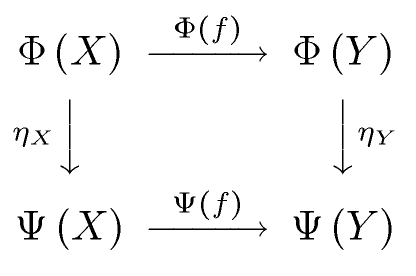Category theory/Natural transformation: Difference between revisions
EndreyMark (talk | contribs) (→Commutative diagram: Definition of notion ``natural transformation'') |
EndreyMark (talk | contribs) m (Commutative diagram is in D category) |
||
| Line 21: | Line 21: | ||
* <math>\forall A \in \mathbf{Ob}(\mathcal C) \longmapsto \eta_A \in \mathrm{Hom}_{\mathcal D}(\Phi(A), \Psi(A))</math>. We call <math>\eta_A</math> the component of <math>\eta</math> at ''A''. | * <math>\forall A \in \mathbf{Ob}(\mathcal C) \longmapsto \eta_A \in \mathrm{Hom}_{\mathcal D}(\Phi(A), \Psi(A))</math>. We call <math>\eta_A</math> the component of <math>\eta</math> at ''A''. | ||
* <math>\eta_Y \cdot \Phi(f) = \Psi(f) \cdot \eta_X</math> | * <math>\eta_Y \cdot \Phi(f) = \Psi(f) \cdot \eta_X</math> | ||
Thus, the following diagram commutes: | Thus, the following diagram commutes (in <math>\mathcal D</math>): | ||
[[Image:natural_transformation.png|center]] | [[Image:natural_transformation.png|center]] | ||
Revision as of 14:46, 3 October 2006
Example: maybeToList
maybeToList map even $ maybeToList $ Just 5yields the same as
maybeToList $ fmap even $ Just 5yields: both yield
[False]Commutative diagram
- Let , denote categories.
- Let be functors.
- Let . Let .
Let us define the natural transformation. It associates to each object of a morphism of in the following way (usually, not sets are discussed here, but proper classes, so I do not use term “function” for this mapping):
- . We call the component of at A.
Thus, the following diagram commutes (in ):

Vertical arrows: sides of objects
… showing how the natural transformation works.
maybeToList :: Maybe a -> [a]Left: side of X object
maybeToList :: Maybe Int -> [Int]
| |
Nothing
|
[]
|
Just 0
|
[0]
|
Just 1
|
[1]
|
Right: side of Y object
maybeToList :: Maybe Bool -> [Bool]
| |
Nothing
|
[]
|
Just True
|
[True]
|
Just False
|
[False]
|
Horizontal arrows: sides of functors
even :: Int -> BoolSide of functor
fmap even:: Maybe Int -> Maybe Bool
| |
Nothing
|
Nothing
|
Just 0
|
Just True
|
Just 1
|
Just False
|
Side of functor
map even:: [Int] -> [Bool]
| |
[]
|
[]
|
[0]
|
[True]
|
[1]
|
[False]
|
Commutativity of the diagram
both paths span between
Maybe Int -> [Bool]
| ||
map even . maybeToList
|
maybeToList . fmap even
| |
Nothing
|
[]
|
[]
|
Just 0
|
[True]
|
[True]
|
Just 1
|
[False]
|
[False]
|
Remarks
evenhas a more general type (Integral a => a -> Bool) than described here- Words “side”, “horizontal”, “vertical”, “left”, “right” serve here only to point to the discussed parts of a diagram, thus, they are not part of the scientific terminology.
- If You want to modifiy the #Commutative diagram, see its source code (in LaTeX using
amscd).
External links
- The corresponding HaWiki article is not migrated here yet, so You can see it for more information.
- Wikipedia's Natural transformation article